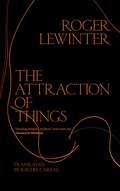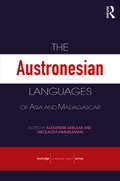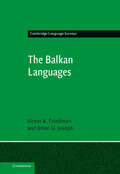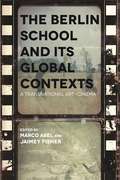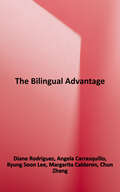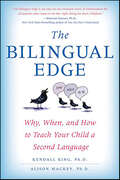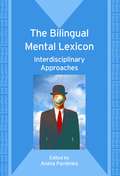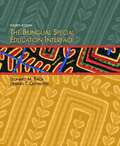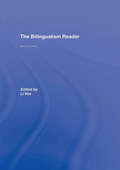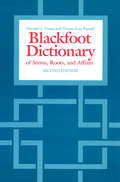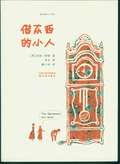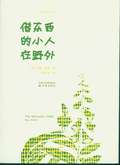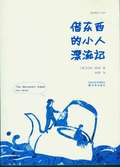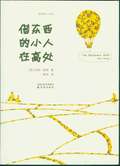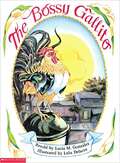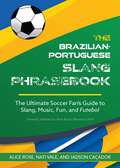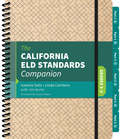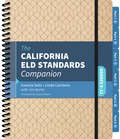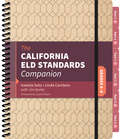- Table View
- List View
The Attraction of Things
by Roger Lewinter Rachel CareauStunning fragments that offer an epiphany of grace and beauty The Attraction of Things concerns the entirety of beauty and the possibility of grace, relayed via obsessions with rare early gramophone records, the theater, translation, dying parents: all these elements are relayed in a dizzying strange traffic of cultural artifacts, friendships, losses, discoveries, and love. Roger Lewinter believes that in the realm of art, "the distinction between life and death loses its relevance, the one taking place in the other." Whereas Story of Love in Solitude is a group of small stories, The Attraction of Things is a continuous narrative (more or less) of a man seeking (or stumbling upon) enlightenment. "The Attraction of Things," states Lewinter, "is the story of a being who lets himself go toward what attracts him, toward what he attracts--beings, works, things--and who, through successive encounters, finds the way out of the labyrinth, to the heart, where the bolt of illumination strikes. This is the story of a letting go toward the illumination."
The Austronesian Languages of Asia and Madagascar (Routledge Language Family Ser. #Vol. 7)
by Alexander Adelaar Nikolaus P. HimmelmannSome 800 Austronesian languages are spoken in the area extending from Madagascar to eastern Indonesia and to the north to Taiwan and the Philippines. They vary greatly in almost every possible respect, including the size and social make-up of the speech communities and their typological profiles. This book is designed to serve as a reference work a
The Balkan Languages (Cambridge Language Surveys)
by Brian D. Joseph Victor A. FriedmanSoutheast Europe's Balkan peninsula is home to numerous languages that have come to converge structurally and lexically, due to complex social factors involving contact among speakers of these languages, constituting a 'sprachbund'. This volume provides the first comprehensive, book-length survey of the Balkan languages in English. It covers the full range of languages involved in the Balkan convergence zone, including Albanian, Aromanian, Bulgarian, Gagauz, Greek, Judezmo, Macedonian, Meglenoromanian, Romani, Romanian, Torlak, and West Rumelian Turkish. Balkan convergences - 'Balkanisms' - are presented, considering the grammatical domains of phonetics, phonology, morphology, morphosyntax, syntax, semantics, pragmatics, and lexicon. It gives attention to relevant notions of contact linguistics and to the history of the field, while also introducing key conceptual innovations. Providing fresh data and perspectives on the most studied intense contact situation, this work is essential reading for anyone interested in Balkan languages. This title is also available as open access on Cambridge Core.
The Berlin School and Its Global Contexts: A Transnational Art Cinema (Contemporary Approaches to Film and Media Series)
by Gerd Gemünden Hester Baer Ira Jaffe Brad Prager Lutz Koepnick Jaimey Fisher Robert Dassanowsky Marco Abel Lisa Haegele William Fech Alice Bardan Inga Pollmann Roger Cook Michael Sicinski Chris Homewood Roland VégsoThe Berlin School and Its Global Contexts: A Transnational Art-Cinema came about in light of the Museum of Modern Art (MOMA)’s 2013 major exhibition of works by contemporary German directors associated with the so-called Berlin School, perhaps Germany’s most important contemporary filmmaking movement. Christoph Hochhäusler, the movement’s keenest spokesperson, stated that "the Berlin School, despite what the label suggests, is not a specifically German phenomenon. All over the world there are filmmakers exploring related terrain." In response to this "transnational turn," editors Marco Abel and Jaimey Fisher have assembled a group of scholars who examine global trends and works associated with the Berlin School. The goal of the collection is to understand the Berlin School as a fundamental part of the series of new wave films around the globe, especially those from the traditional margins of world cinema. For example, Michael Sicinski and Lutz Koepnick explore the relation of the Berlin School to cinema of Southeast Asia, including Apichatpong Weerasethakul and Tsai Ming-liang; Ira Jaffe and Roger Cook take a look at Middle Eastern film, with Nuri Bilge Ceylan and Abbas Kiarostami, respectively. The volume, however, also includes essays engaging with North American filmmakers like Kelly Reichardt and Derek Cianfrance as well as European auteurs like Antonioni, Tarr, Porumboiu, McQueen, and the Dardennes. Bringing German cinema into dialogue with this series of global cinemas emphasizes how the Berlin School manifests—whether aesthetically or thematically, politically or historically—a balancing of national particularity with global flows of various sorts. Abel and Fisher posit that since the vast majority of the films are available with English subtitles (and at times also in other languages) and recent publications on the subject have established critical momentum, this exciting filmmaking movement will continue to branch out into new directions and include new voices. The Berlin School and Its Global Contexts folds German-language cinema back into conversations with international as well as transnational cinema. This volume will be of great interest to scholars of German and global cinema.
The Bilingual Advantage: Promoting Academic Development, Biliteracy, and Native Language in the Classroom
by Angela Carrasquillo Diane Rodriguez Kyung Soon LeeThis comprehensive account of bilingualism examines the importance of using students’ native languages as a tool for supporting higher levels of learning. The authors highlight the social, linguistic, neuro-cognitive, and academic advantages of bilingualism, as well as the challenges faced by English language learners and their teachers in schools across the United States. They describe effective strategies for using native languages, even when the teacher lacks proficiency in a language. This resource addresses both the latest research and theory on native language instruction, along with its practical application (the what, why, and how) in K–8 classrooms. <p><p> Key features include: <p><p> Examples of programs that address the needs of learners from diverse language backgrounds, including Spanish, Chinese, Korean, Haitian Creole, Hindi, Bengali, and Russian. <p><p>Teaching strategies, activities, and student tasks geared toward current academic standards. <p><p>The role of primary language in ESL, dual language, special education, and general education programs.
The Bilingual Child
by Virginia Yip Stephen MatthewsHow does a child become bilingual? The answer to this intriguing question remains largely a mystery, not least because it has been far less extensively researched than the process of mastering a first language. Drawing on new studies of children exposed to two languages from birth (English and Cantonese), this book demonstrates how childhood bilingualism develops naturally in response to the two languages in the children's environment. While each bilingual child's profile is unique, the children studied are shown to develop quite differently from monolingual children. The authors demonstrate significant interactions between the children's developing grammars, as well as the important role played by language dominance in their bilingual development. Based on original research and using findings from the largest available multimedia bilingual corpus, the book will be welcomed by students and scholars working in child language acquisition, bilingualism and language contact.
The Bilingual Child
by Virginia Yip Stephen MatthewsHow does a child become bilingual? The answer to this intriguing question remains largely a mystery, not least because it has been far less extensively researched than the process of mastering a first language. Drawing on new studies of children exposed to two languages from birth (English and Cantonese), this book demonstrates how childhood bilingualism develops naturally in response to the two languages in the children's environment. While each bilingual child's profile is unique, the children studied are shown to develop quite differently from monolingual children. The authors demonstrate significant interactions between the children's developing grammars, as well as the important role played by language dominance in their bilingual development. Based on original research and using findings from the largest available multimedia bilingual corpus, the book will be welcomed by students and scholars working in child language acquisition, bilingualism and language contact.
The Bilingual Child
by Virginia Yip Stephen MatthewsHow does a child become bilingual? The answer to this intriguing question remains largely a mystery, not least because it has been far less extensively researched than the process of mastering a first language. Drawing on new studies of children exposed to two languages from birth (English and Cantonese), this book demonstrates how childhood bilingualism develops naturally in response to the two languages in the children's environment. While each bilingual child's profile is unique, the children studied are shown to develop quite differently from monolingual children. The authors demonstrate significant interactions between the children's developing grammars, as well as the important role played by language dominance in their bilingual development. Based on original research and using findings from the largest available multimedia bilingual corpus, the book will be welcomed by students and scholars working in child language acquisition, bilingualism and language contact.
The Bilingual Edge: Why, When, and How to Teach Your Child a Second Language
by Alison Mackey Kendall King“An easy-to-use treasure trove of information” for parents who want to help their children learn a new language (Deborah Tannen, PhD, New York Times–bestselling author of You Just Don’t Understand).Parents spend millions of dollars every year on classes, computer programs, and toys, all of which promise to help children learn a second language. They want their kids to have the lifelong cultural and intellectual advantages that come from being bilingual—but many of their best efforts (and investments) end in disappointment.In The Bilingual Edge, Georgetown linguistics professors and parents Kendall King and Alison Mackey wade through the hype and provide clear insights into what actually works. No matter what your language background is—whether you never passed high school Spanish or you speak Mandarin fluently—King and Mackey will help you:select the language that will benefit your child the mostfind materials and programs that will assist your child in achieving fluencyidentify your family’s unique traits and use them to maximize learningFancy private schools and expensive materials aren’t needed. Instead, The Bilingual Edge translates the latest research into interactive strategies and quick tips that even the busiest parents can use.
The Bilingual Mental Lexicon
by Aneta PavlenkoHow are words organized in the bilingual mind? How are they linked to concepts? How do bi- and multilinguals process words in their multiple languages? The first aim of this volume is to offer up-to-date answers to these questions. Its second aim is to provide readers with detailed step-by-step introductions to a variety of methodological approaches used to investigate the bilingual lexicon, from traditional neurocognitive and psycholinguistic approaches to the more recent ones that examine language use in context.
The Bilingual Special Education Interface
by Leonard M. Baca Hermes T. CervantesThis book offers an understanding of the major needs of bilingual children who also have disabilities. Chapters highlight the connections between the common knowledge base, programs, and methodologies of special education and those of bilingual education in order to explore the ways to help exceptional children of Asian, African, Hispanic, and Native-American heritage. Practical information is balanced with strong research. Topics include: a judicial perspective on bilingual special education; a development of the bilingual special education interface; language acquisition; issues and assessment; procedures and techniques for assessment; individualized educational programs; instructional plans and curriculum development; methods and materials; family involvement; and issues in policy development and implementation. An excellent resource for teachers, counselors, psychologists, and speech/language specialists.
The Bilingualism Reader
by Li WeiThe Bilingualism Reader is the definitive reader for the study of bilingualism. Designed as an integrated and structured student resource it provides invaluable editorial material that guides the reader through different sections and covers:definitions and typology of bilingualism language choice and bilingual interaction bilingualism, identity and ideology grammar of code-switching and bilingual acquisition bilingual production and perception the bilingual brain methodological issues in the study of bilingualism. The second edition of this best selling volume includes nine new chapters and postscripts written by the authors of the original articles, who evaluate them in the light of recent research. Critical discussion of research methods, revised graded study questions and activities, a comprehensive glossary, and an up-to-date resource list make The Bilingualism Reader an essential introductory text for students of linguistics, psychology and education.
The Blackfoot Dictionary of Stems, Roots, and Affixes
by Donald G. Frantz Norma Jean RussellThis second edition of the critically acclaimed dictionary originally published in 1989 adds more than 300 new entries and amplifies over 1000 others. The Blackfoot Dictionary is a comprehensive guide to the vocabulary of Blackfoot, an Algonquian language spoken by thousands in Alberta and Montana. It contains more than 4,000 Blackfoot-English entries and an English index of more than 5,000 entries, and provides thorough coverage of cultural terms. The transcription uses an official, technically accurate alphabet and the authors have classified entries and selected examples based on more than 25 years of research.
The Borrowers (Mandarin Edition)
by Mary NortonThe Borrowers--the Clock family: Homily, Pod, and their fourteen-year-old daughter, Arrietty, to be precise--are tiny people who live underneath the kitchen floor of an old English country manor. All their minuscule home furnishings, from postage stamp paintings to champagne cork chairs, are "borrowed" from the "human beans" who tromp around loudly above them. All is well until Pod is spotted upstairs by a human boy! Can the Clocks stay nested safely in their beloved hidden home, or will they be forced to flee? The British author Mary Norton won the Carnegie Medal for The Borrowers in 1952, the year it was first published in England. 一个患病的英国小男孩被送往乡间姑婆的老宅中休养 寂静中他发现了在古宅里的一个秘密 借东西的小人 借东西的小人只有铅笔一般高 他们把家安在房子的地板下 靠从楼上的"巨人"那里"借"东西为生 他们最害怕的就是被"看见" 借东西的小女孩阿瑞埃蒂在门外草丛里被小男孩看见 好心的小男孩开始帮助这一家小人借东西 还充当信使 为他们和住在别处的亲戚送信 但好景不长 女管家也发现了小人一家 她关住小男孩 找来警察,猫和捕鼠专家对付小人 万分危急之际 小人一家是如何成功逃脱人类的追捕的呢
The Borrowers Afield (Mandarin Edition)
by Mary NortonPod, Homily, and Arrietty Clock's huge adventures have been thrilling children young and old for fifty years--and their appeal is as strong as ever in these handsome new paperback packages. While the original beloved interior illustrations by Beth and Joe Krush have been retained, Marla Frazee's striking cover illustrations capture these little people with a larger-than-life appeal.波德一家在人类的大搜捕中逃离了地板下的家 开始了颠沛流离的野外生活 他们打算去投奔住在獾洞里的亨德瑞利舅舅一家 但到那里时 亲戚们已不知去向 他们捡到一只破靴子 把它拖到河岸的洞里搭建了一个临时的家 阿瑞埃蒂结识了从吉卜赛人那里借东西的男孩斯皮勒 斯皮勒时常用自己的打猎收获接济这些初到野外的同类 冬天来了 住在靴子里的波德一家弹尽粮绝 喝光最后一点酒后沉沉睡去 醒来发现到了一辆吉卜赛人的大车上 这是怎么回事呢 他们能从吉卜赛人那里逃脱吗 斯皮勒又是怎么帮他们和亨德瑞利舅舅一家团聚的呢 雪貂男孩汤姆是他们的福星还是杀手
The Borrowers Afloat (Mandarin Edition)
by Mary NortonPod, Homily, and Arrietty Clock's huge adventures have been thrilling children young and old for fifty years--and their appeal is as strong as ever in these handsome new paperback packages. While the original beloved interior illustrations by Beth and Joe Krush have been retained, Marla Frazee's striking cover illustrations capture these little people with a larger-than-life appeal.波德一家在斯皮勒的带领下成功脱险 来到小男孩汤姆的住处 与生活在墙里的亨德瑞利舅舅一家会合 但不久 汤姆和爷爷就离开了这里 没有人迹的地方不可能支持两家小人的生活 所以波德不得不又带领家人走上流浪之旅 寻找新的家园 他们从地下管道出走 来到小河边的水壶中安顿下来 但一场突来的大雨将水壶冲到了河水中 小人开始了一场水上漂流冒险 他们最终能找到新家吗
The Borrowers Aloft (Mandarin Edition)
by Mary NortonPod, Homily, and Arrietty Clock's huge adventures have been thrilling children young and old for fifty years--and their appeal is as strong as ever in these handsome new paperback packages. While the original beloved interior illustrations by Beth and Joe Krush have been retained, Marla Frazee's striking cover illustrations capture these little people with a larger-than-life appeal.退休的老珀特先生童心灿烂 闲来无事在家里建起了一个微型村庄 波德一家人迁居来到这里 过起了安逸生活 好心的孟奇思小姐看到了他们 并和阿瑞埃蒂成为好朋友 时常暗中帮助他们 但好景不长 一天 他们被一对贪婪的夫妇抓到自己家的阁楼上 准备到春天就把他们关到玻璃笼子里招徕游客 波德一家人再次陷入绝境 他们在阁楼上度过了漫长的被囚禁的冬天 终于在春天到来前想到了逃走的办法 他们学着报纸上人类制作热气球的技术 制作了一个逃生的气球 再次回到了野外
The Borrowers Avenged (Mandarin Edition)
by Mary NortonPod, Homily, and Arrietty Clock's huge adventures have been thrilling children young and old for fifty years--and their appeal is as strong as ever in these handsome new paperback packages. While the original beloved interior illustrations by Beth and Joe Krush have been retained, Marla Frazee's striking cover illustrations capture these little people with a larger-than-life appeal.波德一家逃离了阁楼里的囚禁生活 回到了模型村庄里的家 因为害怕普拉特夫妇再度前来 他们在斯皮勒的带领下搬迁到了教区长住宅 并遇到了一直居住在那里的博学多才的小人皮尔格林 在大家的帮助下 他们重新找到了适合居住的家园 和亨德瑞利舅舅一家比邻而居 普拉特夫妇心有不甘地继续到处搜寻小人的下落 复活节快到了 阿瑞埃蒂吃惊地发现普拉特夫妇来到了教堂 小人能逃过他们的追捕吗 那贪婪残酷的一对是如何受到惩罚的呢
The Bossy Gallito / El gallo de bodas
by Lucia M. GonzalezÉrase una vez un gallito mandón que iba muy limpiecito a la boda de su tío Perico... Hasta que se ensució y quiso que todos lo ayudarán a volver a estar limpiecito. Un libro muy divertido en inglés y español que deleitará tanto a grandes como a chicos.
The Brazilian-Portuguese Slang Phrasebook: The Ultimate Soccer Fan's Guide to Slang, Music, Fun and Futebol
by Alice Rose Nati Vale Jadson CaçadorLearn to speak like a local before you hit the streets of Sao Paulo or beaches of Rio de Janeiro with this pocket-sized Brazilian Portuguese-English phrasebook.With this book in hand you can get off the sideline and join the local Brazilians as they party from the pitch to the beach. Chock-full of up-to-date slang phrases, after-hours expressions and insider information on futebol, this book will have you cheering, dancing, drinking and celebrating with the die-hard fans of the beautiful game. What&’s up, man? Iaí, cara? Can I join your pickup game? Posso bater uma pelada com vocês? Where is a cool bar to watch the game? Onde tem um barzinho legal pra assitir o jogo? Next round&’s on me. A proxima rodada é minha. We&’re all going to an underground dance club, wanna join? A gente vai pra um baile funk, tá afim? That girl in the VIP section is super hot. Aquela mina no camarote é muito gostosa. Let&’s sleep off our hangovers at the beach. Vamos curar a ressaca na praia.
The California ELD Standards Companion, Grades 3-5: Grades 3-5
by Ivannia Soto Linda J. Carstens James R. BurkeFor California teachers only! Here at last is that single teaching resource for making the critical link between the ELD Standards and the CCSS ELA Standards. Standard by standard, you’ll quickly discover how to integrate language development into your day-to-day content instruction, fully armed with an insider’s understanding of how best to support our many ELs. Horizontal and vertical views reveal how each ELD Standard changes and progresses by grade and proficiency level. What the Student Does sections unpack what meeting a standard looks like in practice. CCSS ELA Standards are displayed side by side with California’s ELD Standards so you can appreciate the purposeful alignment. What the Teacher Does sections provide specific instructional guidance.
The California ELD Standards Companion, Grades 3-5: Grades 3-5
by Ivannia Soto Linda J. Carstens James R. BurkeFor California teachers only! Here at last is that single teaching resource for making the critical link between the ELD Standards and the CCSS ELA Standards. Standard by standard, you’ll quickly discover how to integrate language development into your day-to-day content instruction, fully armed with an insider’s understanding of how best to support our many ELs. Horizontal and vertical views reveal how each ELD Standard changes and progresses by grade and proficiency level. What the Student Does sections unpack what meeting a standard looks like in practice. CCSS ELA Standards are displayed side by side with California’s ELD Standards so you can appreciate the purposeful alignment. What the Teacher Does sections provide specific instructional guidance.
The California ELD Standards Companion, Grades 9-12: Grades K-2
by Ivannia Soto Linda J. Carstens James R. Burke“This is an era of extraordinary promise and support for addressing the needs of California’s English learners. That’s why this book, The California ELD Standards Companion, is so important. It’s exactly the kind of bridge teachers need between standards and what it looks like in the classroom.” —LAURIE OLSEN, Strategic Adviser, The Sobrato Early Academic Language (SEAL) Initiative California teachers: you’re going to love this! Here at last is that single teaching resource for making the critical link between our ELD Standards and the CCSS ELA Standards. Standard by standard, you’ll quickly discover how to integrate language development into your day-to-day content instruction, armed with an insider’s understanding of how best to support our many English learners. Modeled after Jim Burke’s Common Core series, this Grades 9-12 volume of The California ELD Standards Companion is every bit “that version of the standards you wish you had” because it’s just so easy to digest and apply. It’s all here: Horizontal and vertical views reveal how each ELD Standard changes and progresses grade by grade and proficiency level by proficiency level. What the Student Does Sections, also scannable by grade and proficiency level, unpack in student-friendly language what meeting a standard looks like in practice. CCSS ELA Standards are displayed side by side with California’s ELD Standards so you can appreciate the purposeful alignment between the two as the basis for remodeling instructional practice. What the Teacher Does Sections provide specific instructional guidance by grade band, including student prompts and tips for differentiation across proficiency level. A dedicated vocabulary section offers a quick-reference glossary of key words and phrases as they are used within each ELD Standard. Each section concludes with a vignette from the California ELA/ELD Framework to illustrate exemplary standards-based instruction. Thanks to the ELD Standards, we are now free to teach our ELs the way we knew best all along: language and content taught hand in hand across the school day. Lean on Ivannia Soto and Linda Carstens’ California ELD Standards Companion as your one-stop guide for delivering that excellent education our ELs so deeply deserve.
The California ELD Standards Companion, Grades 9-12: Grades K-2
by Ivannia Soto Linda J. Carstens James R. Burke“This is an era of extraordinary promise and support for addressing the needs of California’s English learners. That’s why this book, The California ELD Standards Companion, is so important. It’s exactly the kind of bridge teachers need between standards and what it looks like in the classroom.” —LAURIE OLSEN, Strategic Adviser, The Sobrato Early Academic Language (SEAL) Initiative California teachers: you’re going to love this! Here at last is that single teaching resource for making the critical link between our ELD Standards and the CCSS ELA Standards. Standard by standard, you’ll quickly discover how to integrate language development into your day-to-day content instruction, armed with an insider’s understanding of how best to support our many English learners. Modeled after Jim Burke’s Common Core series, this Grades 9-12 volume of The California ELD Standards Companion is every bit “that version of the standards you wish you had” because it’s just so easy to digest and apply. It’s all here: Horizontal and vertical views reveal how each ELD Standard changes and progresses grade by grade and proficiency level by proficiency level. What the Student Does Sections, also scannable by grade and proficiency level, unpack in student-friendly language what meeting a standard looks like in practice. CCSS ELA Standards are displayed side by side with California’s ELD Standards so you can appreciate the purposeful alignment between the two as the basis for remodeling instructional practice. What the Teacher Does Sections provide specific instructional guidance by grade band, including student prompts and tips for differentiation across proficiency level. A dedicated vocabulary section offers a quick-reference glossary of key words and phrases as they are used within each ELD Standard. Each section concludes with a vignette from the California ELA/ELD Framework to illustrate exemplary standards-based instruction. Thanks to the ELD Standards, we are now free to teach our ELs the way we knew best all along: language and content taught hand in hand across the school day. Lean on Ivannia Soto and Linda Carstens’ California ELD Standards Companion as your one-stop guide for delivering that excellent education our ELs so deeply deserve.
The California ELD Standards Companion: Grades 6-8
by Jim Burke Ivannia Soto Linda CarstensCalifornia teachers: you’re going to love this! Here at last is that single teaching resource for making the critical link between our ELD Standards and the CCSS ELA Standards. Standard by standard, you’ll quickly discover how to integrate language development into your day-to-day content instruction, armed with an insider’s understanding of how best to support our many English learners. Modeled after Jim Burke’s Common Core series, this Grades 6-8 volume of The California ELD Standards Companion is every bit “that version of the standards you wish you had” because it’s just so easy to digest and apply. It’s all here: Horizontal and vertical views reveal how each ELD Standard changes and progresses grade by grade and proficiency level by proficiency level. What the Student Does Sections, also scannable by grade and proficiency level, unpack in student-friendly language what meeting a standard looks like in practice. CCSS ELA Standards are displayed side by side with California’s ELD Standards so you can appreciate the purposeful alignment between the two as the basis for remodeling instructional practice. What the Teacher Does Sections provide specific instructional guidance by grade band, including student prompts and tips for differentiation across proficiency level. A dedicated vocabulary section offers a quick-reference glossary of key words and phrases as they are used within each ELD Standard. Each section concludes with a vignette from the California ELA/ELD Framework to illustrate exemplary standards-based instruction. Thanks to the ELD Standards, we are now free to teach our ELs the way we knew best all along: language and content taught hand in hand across the school day. Lean on Ivannia Soto and Linda Carstens’ California ELD Standards Companion as your one-stop guide for delivering that excellent education our ELs so deeply deserve.
